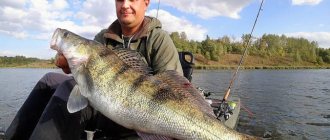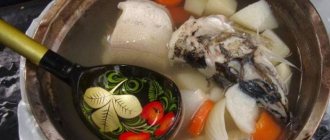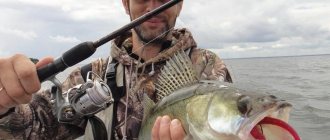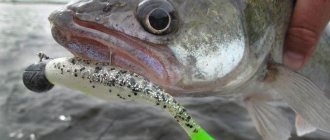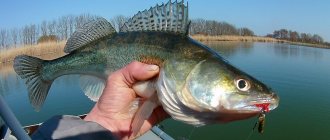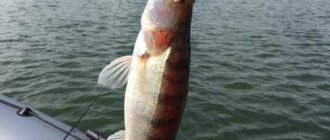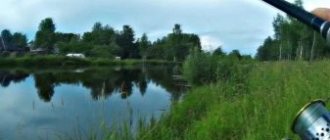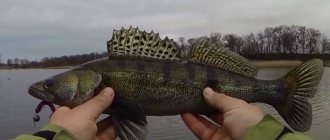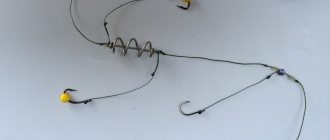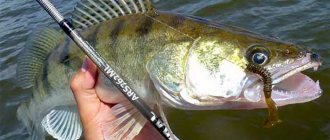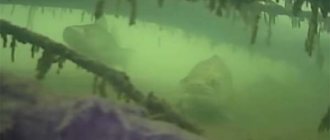Subtleties of catching with bait
Even a beginner can master catching pike with a mandula; there are no particular difficulties in this process. However, everyone should still know some of the subtleties and features of wiring in currents and in still water.
Fishing for pike on the current
Almost everyone who has ever used this bait knows how to catch pike with a mandula on the river. Here the main indicator will be the sinker; its choice should be taken responsibly:
you need to choose sufficient weight, this will allow you to cast long distances and fish bottom sections of the river with good depths
With a quick retrieve, a bait with a large sinker will be able to attract the attention of a predator, and its capture is guaranteed. A passive predator will not chase a fast-moving bait, so in hot weather the choice should be made with smaller weights, but not quite light ones. But at the end of autumn, just before the freeze-up, pike are caught using mandules and foam rubber for demolition, while sinkers are selected of a decent weight
But at the end of autumn, just before the freeze-up, pike are caught using mandules and foam rubber in the demolition, while the sinkers are selected at a decent weight.
Important ! During the current, you need to be able to choose the most effective wiring that will help guide the bait and not scare away the predator.
On still water
In reservoirs with stagnant water, fish behave in a special way. She doesn't stand still. Fish are always in search of food, which means they constantly move throughout the reservoir.
When fishing in still water, you need to take into account the individual preferences of the fish. One fish prefers to be closer to the bottom, while the other hides in the reeds.
You can use a mandula of various colors and sizes.
Sizes and hooks
The size of the bait depends on the number of components and how they will be arranged. The average diameter of the mandula is 8-12 mm, and the length of an individual component is from 15 to 25 mm. These data are approximate.
The total number of sections is 2-3 pieces, less often 4-5 pieces. This sum of parts without a tee with an edge.
The number of components affects the bottom play of the bait. When hitting the bottom, a 2-3 stage mandula has more favorable residual vibrations to attract a predator.
They should be sharp, strong and light in weight. Tees provide more bites and this is their main advantage. But, unfortunately, such hooks catch not only fish, but also snags. But there is a way out - these are single hooks, most often offset. If the offset ones are protected with wire, then they are suitable for fishing in places with a lot of snags, grass and other obstacles for jig fishing enthusiasts.
Mandula is a flight of fancy. The number of sections and hooks depends only on the fisherman, who, when purchasing or manufacturing, proceeds from knowledge of the reservoir and the degree of activity of the fish.
Spinning fishing from the shore and from a boat (spring, summer and autumn)
In the summer and spring, fish are found at the bottom of water holes, hiding under steep banks and in thickets of algae. If it's raining a little or it's cloudy, a bait with an active action is perfect. At night, it is better to use dark mandules.
When fishing from the shore, the recommended rod length is 2.5-3 meters. The reel should be inertia-free and with high speeds. Braided fishing line is wound with a diameter of 1.5-1.8 mm and a length of 100 meters. The finished equipment is attached to the cord, which ensures that the bait flies exactly to the target.
The cast will depend on the location and water flow. The ideal place is the coastal edges. It is necessary to throw the tackle from the far edge to depth. With this fishing technique, there is a problem of snagging snags, in order to avoid this it is necessary to use a jerking technique.
Mandula fishing with a spinning rod continues until late autumn, until the reservoirs are covered with ice. However, winter spinning in open, non-freezing areas (spillways, in places of warm runoff) also shows good results.
The video below shows how to catch passive pike using a mandula.
Plumb fishing from a boat
When fishing from a boat, it is best to equip the mandula with a light weight so that the bait takes a long time to sink to the bottom. This will provide minimal snagging. But the bait game will be at a minimum. When attaching a heavier load, the mandula will vibrate. This further provokes predators, increasing the chance of a great catch. When fishing from a boat, vertical wiring is used. It is necessary to perform the jerking technique with frequent pauses.
What is the tackle?
It is a set of polyurethane foam segments. Which can have different shapes:
- cylinder
- cone
- ball
- cube
These parts are put on treble hooks, connected to each other using winding rings. The classic version of the bait consists of two parts. More complex models are made up of three or four.
The largest tee is installed in the head, the most voluminous part of the mandula. There is a smaller hook in the tail segment. To better attract a predator, it is often equipped with an edge made of the following materials:
- goat hair
- shiny lurex
- Christmas tree tinsel
- bright synthetic threads
Such plumage gives the bait greater mobility during retrieval and makes it as attractive as possible to pike perch. Using a small winding ring, the structure is connected to a Cheburashka weight, the weight of which directly depends on the strength of the current and the depth at the fishing spot.
On lakes and reservoirs, models whose assembled weight is 15–30 g are more often used. On fast, deep-water rivers, heavier options weighing 40–80 g are used.
What kind of fish can you catch?
Polyurethane foam has positive buoyancy, so when it falls to the bottom, the mandula does not lie on the ground, but takes a vertical position in the water, reminding a predator of a feeding fry. Thanks to this feature, it becomes more visible to the fish and can work even in the absence of manipulation by the angler
This design is especially effective when fishing on non-freezing reservoirs in winter, when the fish are not very active. This is ensured by the attractiveness of playing during long pauses. In addition to pike perch, the following can be caught with it:
- pike
- perch
- ide
- asp
- chub
- som
- burbot
Most spinning anglers prefer to make such baits themselves. If you have some experience, you can create models that will be focused on catching a specific type of predator. There are non-hooking versions of the mandula, which are characterized by hooks pressed tightly to the body and work perfectly in conditions of severely snarled water.
Mandula - bait for catching pike perch
With the help of a mandula, you can catch any species of predatory fish, but in most cases it is used to fish for pike perch. Initially, it was invented for these purposes; in some regions, the name “pike-perch killer” was firmly assigned to it.
This is due to the high efficiency of this type of bait, which can be explained by the following features:
Mandula sinks to the bottom, after which he continues to demonstrate a natural and believable performance for some time.
This is a very important feature, since pike perch spends most of its time at considerable depth.
The mandula is clearly visible even in muddy water. Pike perch has fairly poor eyesight, so the risk that it simply does not notice the bait is minimized.
The shape, material and some other features of the design and behavior of the mandula make it a very convenient target for attack by this predator.
Most often he tries to grab it, pressing it to the bottom surface.
Read about the Tyrolean stick, which allows you to improve the bite by increasing the turbidity of the water.
DIY pike perch mandula
Making a mandula for pike perch is carried out according to the same principle as the classic version described above.
There are no fundamental differences between these processes, but the bait must have some features in order to be able to attract the attention of a given predator and be effective in catching this particular prey. All the most significant nuances are discussed in detail below:
All the most significant nuances are discussed in detail below:
The color of the bait is not important to pike perch, but sometimes it may have individual preferences for this parameter, which are formed depending on the living conditions. In other cases, it is recommended to choose the brightest possible material for blanks, especially if the water at the fishing site is quite cloudy, which will allow the predator to see the mandula even at a considerable distance. A good solution would be to combine different bright colors with a segment.
Tees selected for bait must be adapted for fishing for pike perch. First of all, this concerns their size; this parameter must correspond to the dimensions of the desired production
Particular attention should be paid to the material of the hooks, since pike perch is a strong fish and can provide significant resistance when fishing. If you use treble hooks that are too weak, there is a serious risk of the prey jumping off or the bait being spit out.
The tee, which is located at the back of the mandula, is equipped with a front sight
For it, it is better to use tinsel or rain, which is usually used to decorate New Year trees. This measure is again associated with the weak vision of the pike perch, and such elements in the tail part of the bait will create additional glare during the game, which can attract the attention of potential prey.
Not only wire, but also fishing line can be used as connecting elements for different segments. However, it must be strong and have a significant diameter, otherwise there is a risk that the pike perch will simply bite the mandula into several pieces.
It is recommended to use jig heads as sinkers. When fishing for pike perch, this makes special sense, since they allow the bait to remain upright for a longer period of time after diving and contacting the bottom surface. Considering the habitat, behavior and hunting characteristics of pike perch, this greatly increases the chances of a bite.
https://youtube.com/watch?v=sv_Dc7z2RnU
Features of fishing with mandula
There are some features of the mandula that the angler must take into account when fishing.
- The best places for fishing with mandula are various bottom anomalies: holes, edges, depth drops, ledges. Fishing on a flat bottom, although possible, is less effective.
- Snags and underwater vegetation are obstacles when fishing with a mandula. An angler in such a place should either switch to fishing with a non-snagging mandula, or put up with a large number of hooks and losses of bait.
- Although the mandula fishes in reservoirs with stagnant water, it fully reveals its full potential when fishing in the river. During the current, the mandula hangs longer in the water column, additionally sways when touching the bottom, with all these actions strongly attracting the predator. Fishing with a mandula in rivers is much more effective.
- The mandula fishes well with any load, the fisherman should not be afraid of overloading the bait, you can put a load significantly larger than what is necessary for fishing in the given fishing conditions, the mandula will still catch.
- The mandula works not only at great depths, it can be used to fish in shallow areas of the reservoir, even with loads of 20-30 grams.
- Some anglers take several permanent markers of different colors with them when fishing, with which they can quickly change the color of the mandula to better suit their fishing conditions.
- When catching trophy-sized fish, do not be afraid to use mandules 15 cm or more in length. Big fish - big bait.
- Predator preferences are constantly changing, so the angler needs to have in his arsenal mandules of different sizes, colors and types of design in order to be able to choose a bait for specific fishing conditions.
- Mandula is a passive bait, that is, a bait that does not have its own game. Mandula requires active animation on the part of the fisherman. Use different jigs: classic step, dragging along the bottom and tossing.
- To get a good catch, you need to constantly experiment with the color, size of the bait and the method of fishing it.
- Most of the predator's bites on the mandula occur during a pause, when the bait sinks to the bottom. The duration of the pause should be selected based on fishing conditions and fish activity. For active fish, a pause of 1 second may be quite sufficient, but for passive fish, a pause of 10 seconds may not be enough.
- To fish with a mandula, you need the most sensitive tackle, so you should use a fast-action rod and braided line. Such a tackle will allow you not only to feel all the unevenness of the bottom, but to transmit even light touches of the fish to the bait into your hand.
- When fishing with a mandula, bites are often felt as a very gentle touch of the fish on the bait, so in any incomprehensible situation, a hook should immediately follow.
- The mandula is very good at provoking even the most passive fish to bite, so a fisherman can use the mandula as the bait of last resort; if a predator does not take any bait, you can put the mandula and try on it.
Fishing with mandula in summer
In the summer, many people take a vacation and go fishing. It is during the summer season that fish are most active. You can use a mandula of any color. But it is necessary to take into account weather conditions and characteristics of the reservoir.
Where can you find fish in the summer?
- the bottom of water holes;
- under steep banks;
- in algae thickets.
In cloudy weather, it is necessary to use baits that have an active game. In the evening and at night you need to use a mandula of dark shades.
In the summer, stepwise wiring with short stops is used. And sometimes they also use direct wiring.
In July, fish are caught with large and medium baits. The fish can be found in the coastal zone as well as in the eddies. In July and August, fish live in places with weak currents.
DIY mandula: principles of making bait
Mandula is a universal bait for jig fishing, which can be very easily made using available tools. It is widely used by professionals and amateurs of spinning fishing.
Often the mandula is made as bait for catching pike, pike perch, catfish, perch and other predatory fish.
Equipment for making bait
To make your own, you will need a piece of foam plastic. You can purchase it in blocks or sheets at a hardware store, or check out old appliance boxes in the garage. You've probably had foam in one of them for years.
If, due to a difficult coincidence, you were unable to get it, you can use anything you can get your hands on made of polyurethane foam, rubber or any other flexible material: the soles of slippers, a piece of rubber, a piece of a tourist rug.
The second, necessary element that you should buy to make a pike mandula with your own hands is waterproof paint. You can buy cheap paint in the smallest containers, but ideally in powder. It is more resistant to wear and will last you more than one season.
Wool, fine bristles or lurex will be needed to make the “tail” of the mandula.
This is all the material for the mandula that may be needed to make it. Now let's take a look at the tools:
- Pliers;
- Wire cutters;
- Scissors;
- Waterproof glue;
- Knife;
- Awl.
How to make a mandula with your own hands for fishing
Making bait is first and foremost a creative process that requires not only technical knowledge in the arrangement of materials, but also the ability to make them beautiful and eye-catching. Making the base
Making the base
The first step is to choose the colors in which our gear will be.
Important! To make a mandula with your own hands, try to choose the brightest colors possible. Predators react to them more actively
Ideally, you can use two or three different colors for making. Cut three or four circles with a diameter of 0.5-2 centimeters (again depending on the fish you are hunting) and half the thickness of the foam or polyurethane foam. Color half of the circles in your desired color. Allow the material to dry.
Now we divide the foam circles into two identical parts and connect them with glue according to the following principle: painted - unpainted - painted. As a result, we should have two barrels with a central white center.
Important! The central unpainted part contrasts very well with the painted edges. Fishing with a mandula with such bait attracts predators more strongly
The edges of the resulting barrels can be sharpened or smoothed.
Attaching the hooks
In order to attach hooks to our bait and pull wire through it, you need to make a longitudinal hole in the center along the barrel. An awl or a thin iron rod heated under fire is ideal for this procedure.
Make a “ring” type loop from the end of the wire and insert it into one of the barrels. The other end (which was pushed inside) will serve as a fastening for the hook. Make the same loop on it.
We equip the second barrel in the same way and attach it to the hook with wire.
A full-fledged mandula fishing tackle made from two barrels is almost ready, all that remains is to make the finishing touch.
Attach the ponytail
Take long bristles from a brush, red wool or lurex and, if desired, dye them in any color you like.
Using a thin fishing line, pull them from one edge and tie them in such a way that the fibers do not fall out when twisted too hard.
Tie the tail onto the ring of the hook or glue it using auxiliary means. The main condition is that the fibers stay along the hook and are mobile.
Manufacturing features for different types of fish
Each predatory fish reacts to individual baits differently. While walleye will chase a jig of any size and in almost any season, pike and catfish will be selective in their prey's size, length, thickness, etc.
The optimal mandula for pike perch: 5-15 centimeters in length, and the mandula for catfish and pike: from 5 to 30 centimeters, it all depends on the size and hunger of the predator.
Interesting. Foam and polyurethane foam lures create more realistic movements with less influence of current or rod twitch compared to silicone and latex options.
When catching predatory fish, periodically make light twitching movements with the rod.
At the same time, baits will more actively attract attention to themselves.
Edge
To make the edge, you can use various visually attractive materials: shiny New Year's tinsel, colored threads, bright fishing cord (braid), silicone baits (in the form of octopuses, etc.), and of course Lurex and other fly fishing materials. I mainly use Lurex as edging for mandulas; it is very convenient, not expensive, impressive and effective.
I use several colors: red, light green, green, light yellow, sometimes black, etc. I add silver lurex to all colors, that is, I get a two-color combination, which, in my opinion, is more attractive to fish (I admit a subjective approach here , maybe this is not the case).
There are ambivalent opinions among fishermen regarding the length of the edge: some believe that it is enough for it to protrude beyond the hook hook by only 1–1.5 cm, while others, on the contrary, use long “panicles”, up to 5–6 cm or more. I usually use an edge that protrudes beyond the hook hook by 2.5–3.5 cm, sometimes more. Here you can experiment.
In fishing practice, there are cases when fish are very selective about the size of the bait and prefer very small mandulets - 4 or 5 cm long (not counting the rear tee).
In this case, the body volume is small and the mandula may take a more inclined position than would be desirable or than the fishing conditions require. Increasing the volume of the fixator put on the end tee means reducing the already low clamping capacity of the small tee. A combined edge may be useful here: lurex + EVA strips. This edge has positive buoyancy, is very mobile and responsive to manipulation of the bait. It is very simply made by adding a pair of 1-2 mm strips of thin EVA, which can be purchased at any craft store (foamiran).
You can fix such an edge on a tee with a piece of heat-shrinkable tubing or EVA, but it is better with a bright cambric or a small luminous silicone ball.
To increase the attractiveness of the edge on strips of foamiran, you can draw transverse stripes or dots of different colors on strips of foamiran with a waterproof marker, or you can use foamiran with sparkles. The disadvantage of such a floating combined edge is its fragility. But a silicone ball or cambric allows you to quickly replace a frayed tail; you just need to move them towards the mandula’s body, insert fresh strips of pre-cut material into the eye of the tee and fix them again with a silicone cambric or ball.
This technique can also be used to “straighten” larger mandules. By the way, the entire body of the bait can be formed from strips of foamiran, threading not two strips into each hook, but 8–10 or more...
This is where I end my story, dear fishermen, but fishing experiments continue, while for others they are just beginning or are about to begin. I would like to sincerely wish you creative success and no tail, no scales while fishing.
Fishing with mandula flag
There are different types of mandula. A checkbox is one of the varieties.
The flag mandula is made of polyurethane foam and other materials. Sometimes two materials are combined. The flag is equipped with two hooks, numbers 8 and 12.
Various colors available:
- violet-green;
- White black;
- black-green;
- yellow-red;
- green-red;
- white-yellow.
Any predatory fish will bite the flag mandula. If necessary, can be combined with other baits. She doesn't have her own game.
Mandula fishing technique
It is better to catch pike perch on the edges, where the bottom is uneven and the depth varies. The nozzle is brought to the place where the depth rise increases. The bait for zander is carried out against the direction of the water. When the weight reaches the bottom, the bait game begins.
Options for fishing with a mandula:
Carefully, without sudden movements, gradually wind the reel, thereby dragging the nozzle along the bottom. 2-3 reels are made in a row, then a pause, and the bait touches the bottom. Also popular among anglers is a leash with one quick toss and a long pause.
This is done so that the tool rests on the bottom again. The fish attacks the bait during pauses on the bottom. The fact that the prey is about to be hooked is indicated by a strong blow - this means that the pike perch has crushed the nozzle. Next, you need to pause for 2-3 seconds and wait for the cord to tighten. When the line begins to tighten, the angler should take this as a signal for a control hook, after which he will have to fight with his prey. The pike perch calms down after several jerks with the spinning rod.
Fishing with mandula in spring
Active fishing for predators begins in the spring at the beginning of March. At this time, fish attack almost any bait. The best time to fish in spring is morning, evening and night.
In spring, large baits are used. At this time of year, give preference to light shades.
Where to look for fish in spring?
- shallow water areas;
- under steep banks.
In the spring season, hunger begins.
This is the best time to catch these fish:
- pike;
- perch;
- salmon, etc.
Catching predatory fish
The design features of the mandulas make these baits effective. When they fall to the bottom of the reservoir, they continue to sway, imitating the movements of a fish. This attracts a predator, which rushes to the bait almost immediately. Depending on the body of water and the type of fish that will be hunted, you can determine how to fish with a mandula correctly, with maximum efficiency.
Pike perch and mandula
Classic fishing for pike perch with live bait or lures is a sporting and exciting activity.
It is no less, and maybe even more interesting, to catch this fish with homemade gear. A do-it-yourself pike perch mandula should consist of at least two parts, but it’s better if there are three. An effective fishing tactic is to use step-by-step fishing. The bait is thrown and waited until it sinks to the bottom. After this, the line is tightened by making 2-3 turns of the reel. Then a pause of 3-4 seconds and again wiring 2-3 turns.
If the bite is bad, when the pike perch is picky, pauses are increased to 10 seconds. This method often works, and the fish grabs the bait during a pause. The activity of pike perch will be enhanced by impregnation of the mandula with a liquid flavoring, for example, fish oil.
When fishing from a boat, throws are good. Their essence is that the mandula is thrown into a deep place and then rises with sharp jerks. In this case, the bait moves vertically. A three-meter spinning rod with a line cast of 10 meters is suitable for this.
Pike hunting
You can make a mandula for pike yourself in the same way as for pike perch. It may be larger in size if large specimens are to be caught.
Mandula fishing is good where the bottom is sandy, shell or pebble, without large snags and household debris.
More often, pike are caught at the bottom than in the water column, but it is not necessary to catch them every time. Use uniform, jerky and stepped wiring. Its speed depends on the activity of the predator - the more active the pike, the higher the retrieve speed.
During pauses, the mandula creates the impression that a fry is feeding at the bottom, this naturally attracts a predator. Even with a small current, all parts of the bait play, painting a very believable picture. The faster the current, the longer the pauses. Sometimes you have to wait up to 30 seconds.
Vertical fishing from the boat is the same as when fishing for pike perch.
Perch fishing
Small mandules ranging in size from 3 to 5 cm in length and weighing about 10 grams are suitable for fishing perch. Models consist of 2-3 segments. Instead of lurex, you can attach red threads or silicone fringe.
In still water bodies, it is enough to find a clean patch of bottom for fishing to be successful. If the bottom is littered, then the wiring can be raised so as not to cling to possible obstacles.
To begin with, make several even movements without pauses or twitches. If the technique does not work, use a stepwise option. The wiring technique is no different from that used when fishing for pike perch and pike perch.
Ideally, try all types of wiring. It depends on your luck - either there’s a bite or there’s not. You can irritate a passive perch with this technique: when retrieving in steps, make only half a turn of the reel, and then a short pause. The mandula moves along the bottom in small jerks. Perhaps the success of such wiring is that the perch mistakes the mandula for a wounded fry, but this is only an assumption.
How to catch pike perch using a mandula
When fishing for pike perch, the mandula is carried out on the edges, where distinct changes in depth begin, moving the bait towards an increase in the depth level of the reservoir. On rivers, this pike perch top bait is held against the current. After casting, the tool is allowed to reach the bottom, after which the animation begins.
You can fish with a mandula using several types of fishing. After reaching the bottom, the angler can begin to slowly reel in the line with the reel, simply dragging the bait along the bottom, without pauses or tosses. The second method is similar to the classic jig, when a step is made through two or three reels with a pause and touching the bait to the bottom. A popular type of retrieve is a quick toss of the bait with a long pause, allowing the fishing tool to lie to the bottom again. The attack of the predator in most cases occurs during pauses, when touching the bottom. The pike perch presses down on the bait, which the angler feels with a distinct blow, after which, after a 2-3 second pause, the cord is tightened by the hooked fish.
This pull-up is the signal for the control hook and the start of the fight against the trophy. The fight itself is fleeting; after a couple of jerks, the pike perch stops all movements and pulls itself up to the fisherman with the expectation of securing a trophy using a landing net.
DIY making
Today it is quite easy to buy a ready-made mandula. However, making it yourself is not at all difficult. A homemade bait may look less attractive from an aesthetic point of view, but this does not affect its properties.
For production you will need the following materials:
- tees of several sizes;
- driving material or wire;
- lurex or wool that does not get wet;
- winding rings;
- material with good buoyancy.
Any polymer, cork or hard foam is suitable for the base of the mandula. You can use a foam travel mat, a soft children's construction set, or old beach flip-flops.
You can make the design according to the instructions.
- Glue the polymer blanks together taking into account the color combination.
- Cut the material into cones, circles or squares. Some craftsmen use a punch or a piece of pipe for this. In the latter case, you should first sharpen one edge.
- Round the cylinder or make a cone out of it. To do this, the polymer is fixed to a drill bit and processed using an emery sheet.
- Make a hole in each workpiece with a hot awl and thread a wire or leash through it. Be sure to tie a loop at the end. Insert the winding ring.
- Thread the tee into the hole. The workpiece is, as it were, mounted on the shank of the hook.
- If the parts were made of the same color material, then it’s time to paint them. It is worth alternating shades to create contrast. You can simply combine stripes of light and dark colors.
- Combine all the details of the mandula into a single design.
- Disguise the tees with wool or lurex.
Fishermen use various materials and accessories when making bait. However, the whole process still follows the same principle. With experience, you can improve the design by using more or fewer links, selecting tees of different sizes
It is only important to place the largest hook in the head of the mandula, and the smallest one in the tail.
When making it yourself, there are no clear rules for designing the color scheme. A fisherman can follow the advice of experienced craftsmen or simply use his imagination. It is better to make red stripes in the tail. It is not recommended to design the elements themselves in more than two colors. Larger amounts may scare away the pike.
You can also make a mandula using a propeller. This modification makes the bait much more effective. Pike respond better to a mandula that moves and does not just freeze in the water. On the other hand, predicting the behavior of a predator is not so easy. It is necessary to experiment with fish in each individual body of water to understand its feeding habits.
How to make a mandula with your own hands
Nowadays, you can buy bait at any fishing store, but making it yourself is not difficult. It's not difficult and fast. Detailed process of how to make a mandula step by step in the video:
To make your own mandula you will need:
- Material with positive buoyancy - polyurethane foam, cork, rigid foam, etc. For example, old travel rugs (EVA) are also suitable.
- Tees of various sizes.
- Wire.
- Wind-up rings.
- Lurex.
Manufacturing:
- Blanks of different colors must be glued together to form multi-colored cones or cylinders;
- Cut the mandula pieces into conical, round or square shapes;
- To round the shape, you need to fix the workpiece on a drill bit and adjust it with an abrasive while rotating;
- In the center of each workpiece, a hole is made with a hot awl, a wire is inserted into it, and a loop is made at the end into which the winding ring is threaded;
- At the same time, a tee is threaded into the hole;
- Colors must be alternated. For example, first light and then dark shades;
- Next, all the parts are connected together;
- The final touch is masking the hooks with lurex.
Non-hook mandula on offset hook
This bait is securely fixed on an offset hook through two punctures; the hook tip is hidden in the body of the mandula. When biting, the sting is released and pierces the body of the prey.
The following video will teach you how to make a non-hooking mandula on a pike with your own hands quickly and easily:
Mandula is a universal bait that is suitable for all types of fish. It is used not only by professional fishermen, but also by amateurs at any time of the year. Making a mandula yourself will save your budget, and having it in your arsenal will give you a guarantee of a good catch.
Views: 4,469
Manufacturing scheme
The technology for making such baits with your own hands can be different. In this case, everything will depend on which predators will be hunted. You should also decide on the sizes of future products.
For zander
For such fish, you need to choose the right base. The best option would be polyurethane. Sometimes unnecessary residues from insulation are used. Remember that for pike perch you should select the sharpest small hooks (double or tee).
- For mandula fishing for pike perch, you should use special eared weights. At the initial stage, the polyurethane plates are securely glued together using a special waterproof adhesive composition. If the thickness of the material is more than 1 cm, then there is no need to glue anything together; one whole element may be enough.
- The cut washers are carefully threaded onto the knitting needle, which will act as an axis, and then the whole thing is firmly glued together. As a rule, the head and body of the bait are made no more than 2–2.5 cm long. The length of the tail should be about 0.5 cm. Remember that for pike perch it is recommended to select cone-shaped washers.
- After gluing, you need to grind the bait blank. This is done in order to give the product the required shape.
- Later, the neck and head of the artificial fish are trimmed a little with a utility knife so as to form a cone-shaped shape. The tail can be made in the form of a cylinder.
- At the end, excess pieces of materials are also carefully cut off.
- Then a small frame is formed for the artificial bait. To do this, 2 hooks are attached to such a base: one on the head of the fish, and the second on the tail. A tee is firmly attached to one of the ends of the metal wire; for this you will need to make 2 rings on it.
- The hooks are fixed on one ring, the second is simply connected together with the main fishing line. A thin plastic tube is attached inside the product; its ends should be melted a little, but the hole should be preserved, because it is through it that the wire will be threaded, which connects the tail and head of the artificial fish. Thus, you should get a fairly catchy mandula for pike perch.
In this case, the manufacturing technology will be almost the same as in the previous version.
For pike
For such a predator, it is better to make a mandula consisting of 2-4 separate elements. Its total length should reach about 8–15 cm. Pike has a fairly wide mouth, so the product should be made with rather large dimensions so that it does not fly out during the fishing process.
In addition, experienced fishermen noted that pike respond best to baits made in black and white colors, which is why they should be used in production.
For perch
To hunt this predator, you also need to form a preparation, as in the first case for pike perch. But at the same time, its size should be smaller, since the perch bites on small baits.
